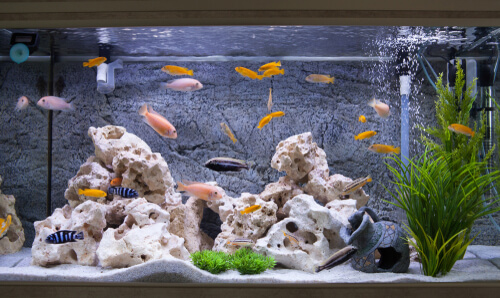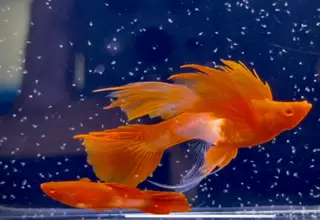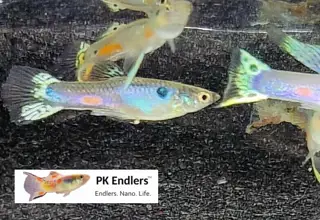African Cichlids vs South American: Which to Choose?
Posted by on 08/02/2023
Both African and South American cichlids are rewarding fish to keep. If you're looking to build out the cichlid tank of your dreams, you'll likely have to decide between these two types of Cichlids.
While they both descend from the same family of fish, African cichlids and South American cichlids share some key differences that may sway your purchasing decision. In this post, we'll compare both African and South American cichlids, so that you can decide which fish is right for you.
January's Giveaways on Light Fish
African Cichlids
African cichlids hail from three large lakes in Eastern Africa, Lake Tanganyika, Lake Victoria, and the most diverse - Lake Malawi. Over 1300 cichlid species exist in these lakes, with many still undocumented.
African Cichlids that exist in these lakes are often categorized into three different groups that vary in size and appearance: Haplochromis, Mbunas, and Peacocks (we cover the differences in a related post of ours: The African Cichlid: Everything You Need To Know).
In the aquarium hobby, some of the most commonly seen African cichlids are typically Mbunas and include the popular yellow lab, demasoni, and zebra mbuna. Due to their smaller size, African cichlids require less space than their South American counterparts, and reward hobbyists with their stunning variety of color.
Best of all, hobbyists can mix different species of African cichlids, just be sure to introduce them at the same time to prevent any territorial disputes and aim for one male for every 3 females.

South American Cichlids
If your tap water is considered soft, or you have access to RO/DI water, you'll be able to care for South American Cichlids. In the wild, these fish can be found swimming throughout the Amazon River Basin and the rivers of Central America. Some of the most sought-after cichlids in the hobby are South American Cichlids, and they include the Cuban Cichlid, Electric Blue Jack Dempsey, and the Tiger Oscar.
However, not all South American Cichlids are large - smaller-sized South American Cichlids exist, and include the German Blue Ram, the controversial Balloon Ram, and the attractive looking Apistogramma genus.
Hobbyists looking to acquire South American Cichlids should look up the individual care requirements of the fish that pique their interest. Due to the stark differences in size, each fish will have different care requirements, and one species may easily show signs of aggression towards another.

Best for Large Aquariums
Unless you're going with a South American Oscar or Cuban Cichlid (which are quite large), African Cichlids are best suited for a large aquarium (50 gallons+.) African Cichlids will become territorial, so having plenty of space and a 1:3 male: female ratio is essential in creating a healthy ecosystem.

Best for Small Aquariums
If you prefer a smaller, nano-sized aquarium, you can't go wrong with South American cichlids - specifically Apistogramma. While some of the other South American cichlid species require larger tanks, members of the Apistogramma genus are an exception, as these fish only require 20 gallons of space, and will grow to reach about 3.5 inches in length. Aim for one male for every two to three females if you plan on keeping a group of these fish.
Best for Planted Tanks
While we've seen hobbyists successfully keep dwarf South American cichlids in planted tanks, we've seen some unique-looking planted African cichlid tanks emerge over the past few years.
While African Cichlids have earned a reputation for picking at plants, hobbyists have created unique aquascapes utilizing different species of anubias in their African cichlid tanks. Hobbyists will glue the roots of an anubias plant, such as anubias frazeri to rockwork or driftwood to create an eye-catching aquascape that pairs nicely with the bright colors from African cichlids such as the Yellow Lab.
If you're looking for some further inspiration for your Cichlid Tank, we've got you covered in our related post: Cichlid Tank Ideas: Hardscape Options, Plants & More.
🛒 Shop Freshwater Fish on Light Fish
Best for Hobbyists with Hard Tap Water
Love it or hate it, water changes are an essential part of fish keeping, and if you live in an environment where hard water comes from the tap, you'll be well positioned for an African Cichlid tank.
The lakes of Tanginka, Victoria, and Malawi are rich in minerals, resulting in alkaline water, which is closely replicated by hard tap water.
Best for Hobbyists with Soft Tap Water
Hobbyists that live in more rural environments may have access to softer water. If your water source at home is considered soft, South American cichlids may be the right choice. The waters of Central and South America are much softer than the African lakes, and hobbyists will have no problems keeping South American cichlids at home.
Plus, if you ever decide to venture out of cichlid keeping and into the planted tank scene, you'll be able to grow some of the most attractive-looking aquatic plants in the hobby.
For those of us with hard water, it is possible to create soft water at home, but you'll need an RO/DI unit to make it happen.
Conclusion
African and South American cichlids are incredibly rewarding to keep and have been staples in the hobby for generations. Now that we've discussed some of their differences, which do you think you'll choose? Let us know in the comments, and be sure to visit our marketplace where you can purchase cichlids from trusted vendors across the United States.
January's Giveaways on Light Fish






